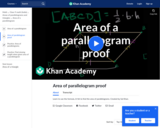
Showing that the area of a parallelogram is base times height
- Subject:
- Geometry
- Mathematics
- Material Type:
- Lesson
- Provider:
- Khan Academy
- Author:
- Khan Academy
- Date Added:
- 09/22/2013

Showing that the area of a parallelogram is base times height

Proof of the Pythagorean Theorem using similarity

Proving that vertical angles are equal

Showing that the centroid divides each median into segments with a 2:1 ratio (or that the centroid is 2/3 along the median)

Right triangles and the Pythagorean Theorem

How to measure an angle in degrees

Showing that an inscribed angle is half of a central angle that subtends the same arc

This video is from the Khan Academy subject of Math on the topic of Geometry and it covers Specifying planes in three dimensions.

This video is from the Khan Academy subject of Math on the topic of Geometry and it covers Area of shaded region made from equilateral triangles.

This video is from the Khan Academy subject of Math on the topic of Geometry and it covers Measuring volume with unit cubes.

This video is from the Khan Academy subject of Math on the topic of Geometry and it covers Constructing a perpendicular bisector using a compass and straightedge.

Finding the volume and surface area of a cylinder

Learners review the fundamental laws of algebra including the commutative law of addition, the commutative law of multiplication, the associative law of addition, the associative law of multiplication, and the distributive law. Examples are given.

In a series of practice problems, learners use the substitution method to solve systems of linear equations, also called "simultaneous linear equations."

In this interactive object, learners simplify ratios and solve problems using proportions. All terms are defined.

Learners review the basic math operations involving zero, emphasizing that division by zero is undefined. Examples are given.

Seeing that the centroid is 2/3 of the way along every median

This text is intended for a brief introductory course in plane geometry. It covers the topics from elementary geometry that are most likely to be required for more advanced mathematics courses. The only prerequisite is a semester of algebra.
The emphasis is on applying basic geometric principles to the numerical solution of problems. For this purpose the number of theorems and definitions is kept small. Proofs are short and intuitive, mostly in the style of those found in a typical trigonometry or precalculus text. There is little attempt to teach theorem-proving or formal methods of reasoning. However the topics are ordered so that they may be taught deductively.
The problems are arranged in pairs so that just the odd-numbered or just the even-numbered can be assigned. For assistance, the student may refer to a large number of completely worked-out examples. Most problems are presented in diagram form so that the difficulty of translating words into pictures is avoided. Many problems require the solution of algebraic equations in a geometric context. These are included to reinforce the student's algebraic and numerical skills, A few of the exercises involve the application of geometry to simple practical problems. These serve primarily to convince the student that what he or she is studying is useful. Historical notes are added where appropriate to give the student a greater appreciation of the subject.
This book is suitable for a course of about 45 semester hours. A shorter course may be devised by skipping proofs, avoiding the more complicated problems and omitting less crucial topics.

ACCUPLACER Instructions, Practice Problems, & YouTube Videos is comprised of various direct links to other websites ("Linked Sites"). These links are provided simply as a convenience to other NCLOR users.

ACCUPLACER Instructions, Practice Problems, & YouTube Videos is comprised of various direct links to other websites ("Linked Sites"). These links are provided simply as a convenience to other NCLOR users.